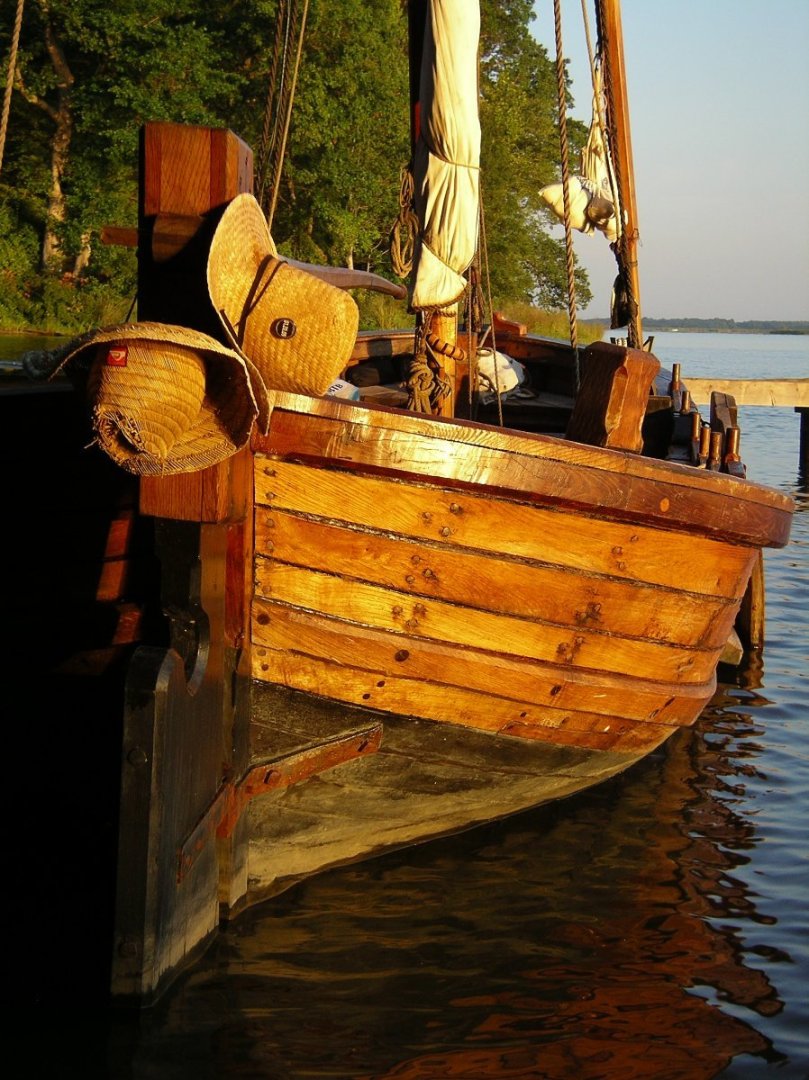-
Posts
8,149 -
Joined
-
Last visited
Content Type
Profiles
Forums
Gallery
Events
Everything posted by allanyed
-
This may in fact be the case, but these models are hundreds of years old and many have been repaired, refinished, re-rigged, etc. There could have been damage to the catheads from an incident or vermin and taken off the model. The below photo from James Lees' Masting and Rigging English Ships of War is just one example of such damage. The stem has been eaten away as was at least one of the catheads. Both contemporary models and plans are fantastic sources but I would trust contemporary based as-built plans and even design plans before the models. Allan
- 148 replies
-
- Vanguard Models
- Cutter
-
(and 2 more)
Tagged with:
-
The article by David Antscherl on planking in the data base on planking explains lining off as well. https://thenrg.org/resources/Documents/articles/APrimerOnPlanking.pdf To get any of the Passaro vids, just Google Chuck Passaro planking video part 1 or 2,,,, or 3,,,, or 4 Allan
- 26 replies
-
Welcome to MSW Christopher! Regarding your choice of first models,
-
VERY HAPPY to have you aboard. Welcome to MSW Allan
-
(The following may be an exaggeration)...... There are a thousand discrepancies when comparing modern plans and contemporary plans, and hundreds between contemporary plans and contemporary models as well. Regarding contemporary models, many have been refurbished/repaired over the past 200 to 300 years so a little care needs to be taken in relying on these gorgeous pieces of art. Common sense is often forgotten so good for you not to ignore it. Allan
- 66 replies
-
- 18th Century Armed Longboat
- Model Shipways
-
(and 1 more)
Tagged with:
-
As this is only your second kit, the suggestions above about getting a high quality kit are spot on. Maybe try a kit or two that will teach proper build techniques including planking. The 3 model beginner series from Model Shipways or the Syren Medway longboat kit along with spending time studying the tutorials here at MSW in the articles database will make your journey a pleasant one. Allan
-
The plans may be wrong if the contemporary plan ZAZ7322 in the RMG Collections is correct which shows what I think is the horse above the tiller. Allan
- 66 replies
-
- 18th Century Armed Longboat
- Model Shipways
-
(and 1 more)
Tagged with:
-
Hi Eberhard, It was introduced to artists paints in the 1960s, Unbleached Titanium (pigment index number PW6 or PW6:1) is a shade of yellow-grey that can be described as being like parchment, suede, or sand. As its name and pigment index number suggests, it is closely related to Titanium White. However, its characteristics are very different and the possibilities it offers in color mixing are unlike any other pigment. Allan
-
Will there be a stave around which the futtock shrouds ran before being seized to the lower shrouds? Allan
-
The model looks very nice. There is one thing that looks new for me. Regarding the lower masts I see a rope woolding without the requisite wooden hoops but also what look like iron bands. From James Lees' The Masting and Rigging of English Ships of War, page 2, "Iron bands superseded rope wooldings in 1800. They were 3 inches wide" (1.2mm at 1:64) From the photos the bands on the model look to be about 8 or 9 inches ( 3.5mm). As Indefatigable was near the time of transition, would there have been a mix of the types of rings used and a variety of sizes? Allan
- 233 replies
-
- Indefatigable
- Vanguard Models
-
(and 1 more)
Tagged with:
-
Toni, This may be off the wall, but would you consider setting your build aside and get some experience with high quality beginner models such as the 3 part series from Model Shipways designed by David Antscherl and/or the terrific Medway longboat kit by Chuck Passaro at Syren Ship Models. You will learn how to properly plank as well as a lot of other things that will carry over to future more complex builds. Just a thought that may prevent a lot of frustration. If you would rather stay with the kit you already have, the suggestion above to study the planking tutorials as well as the four part You Tube series on proper planking is key. https://www.youtube.com/watch?v=KCWooJ1o3cM Allan
- 26 replies
-
Tim, it really is close to what I am shooting for and Vallejo gets much better reviews than the cheap bottled craft acrylics. I still hesitate to use any bottled paints after spending so much time on the model. I have never had problems with high qual artist tubed acrylics so may stay with that and mix my own. I am wide open to trying new things but this one scares me a little. Any feedback on using this particular paint brand would be welcome. Chuck, very good point. I have not used unbleached t.w. for a while and totally forgot about it. Worth buying a tube and comparing colors. Thanks guys, much appreciated!!!
-

Question about Symbol on building mast
allanyed replied to ChuckP's topic in Masting, rigging and sails
This is partially correct. "B" is the cross section (looking down) at the point where the arrow indicates, it is not from the top of the mast which would have included the cap. Another common convention would be as below Allan -
Welcome to MSW. Had to look up fourteeners, and see that they are mountains over 14,000 feet. Gotta be gorgeous. French horn and bass guitar....... ahhh a man of many talents. IF you get frustrated with your first choice, do look at the three model series designed by David Antscherl from Model Shipways. They will help you develop good habits and explain how planking and other construction details are supposed to be done rather than following make believe practices. Allan
-
I reached out to Chris Cerino of the Sultana Education Foundation and he concurs that the John Smith shallop would most likely have been carvel built. To that end when they built the replica (below photo) it was carvel built. How the kit came to be lapstrake is a mystery and based on what has come up so far, may not be right. Further, some interesting things from the Sultana group, 1. the shape of the vessel was inferred largely from the small shallop shown on John Smith's 1612 map of Virginia, which shows an open, double-ended vessel with one mast, one spar, and some simple shrouds (two on each side) 2 it is a two-pieced design based on an account from Captain Bartholomw Gosnold, who led an expedition to Cape Cod in 1602 where he mentions that, upon sighting land and setting anchor, the crew "launched the one half of our shallop." After rowing this "half shallop" to shore and exploring for the day, he notes that "the other part was rowed to shore and set together" Lots of guess work but interesting none-the-less Allan
- 36 replies
-
- Shallop
- Pavel Nitikin
-
(and 1 more)
Tagged with:
-
I do agree with you that she was likely carvel built. This sketch is of a boat built in recent years by the Sultana group but I cannot find anything in their writings that indicate this design is anything more than their best guess. Perhaps they have contemporary evidence of such and that would really be worthwhile to see such information. Allan
- 36 replies
-
- Shallop
- Pavel Nitikin
-
(and 1 more)
Tagged with:
-
I have always done the rails, then the head timbers and it is a royal pain in the neck. I will have to give your route a try on the next one.😀 Allan
- 648 replies
-
- Indefatigable
- Vanguard Models
-
(and 1 more)
Tagged with:
-
Welcome to MSW Mr. Cougar It would be polite if you posted a little intro about yourself in the new members forum. If you are not committed strictly to the Bluenose there are plans of other Grand Banks schooners such as the Ernestina (ex Effie M. Morrisey) available from the US National Archives, including photos. As she was recently rebuilt at Bristol Marine, they might share even more details with you. Allan
- 58 replies
-
Not in my house. Regardless of the project being a kit or scratch, research is extremely beneficial and that might to something to share. Otherwise, unless your interests in ship, nation, era, priorities such as accuracy, et al, are identical it may be better for each to have their own project, even if it is the same vessel. You may have something special though and can work together, but someone is going to have to make decisions when the inevitable stumbling block appears. Welcome aboard😀 Allan
-
Thanks David Again I see both, especially the last one, object-12551 appearing to follow the sheer of the wales. The first is harder to see but object-12537 and object-15235 are very clear that they parallel the water line. Another quandry😕 Thanks again Allan Some models from RMG as well. https://www.rmg.co.uk/collections/objects/rmgc-object-66327 https://www.rmg.co.uk/collections/objects/rmgc-object-66374 https://www.rmg.co.uk/collections/objects/rmgc-object-66407 https://www.rmg.co.uk/collections/objects/rmgc-object-66403
-

Help for blocks with hoop required.
allanyed replied to Tony28's topic in Masting, rigging and sails
I would find a more reliable source which is based on actual practice such as Chapelle et al to confirm or correct their interpretations. For example the line runs under the horse, which would never work, rather than to the block. Allan
About us
Modelshipworld - Advancing Ship Modeling through Research
SSL Secured
Your security is important for us so this Website is SSL-Secured
NRG Mailing Address
Nautical Research Guild
237 South Lincoln Street
Westmont IL, 60559-1917
Model Ship World ® and the MSW logo are Registered Trademarks, and belong to the Nautical Research Guild (United States Patent and Trademark Office: No. 6,929,264 & No. 6,929,274, registered Dec. 20, 2022)
Helpful Links
About the NRG
If you enjoy building ship models that are historically accurate as well as beautiful, then The Nautical Research Guild (NRG) is just right for you.
The Guild is a non-profit educational organization whose mission is to “Advance Ship Modeling Through Research”. We provide support to our members in their efforts to raise the quality of their model ships.
The Nautical Research Guild has published our world-renowned quarterly magazine, The Nautical Research Journal, since 1955. The pages of the Journal are full of articles by accomplished ship modelers who show you how they create those exquisite details on their models, and by maritime historians who show you the correct details to build. The Journal is available in both print and digital editions. Go to the NRG web site (www.thenrg.org) to download a complimentary digital copy of the Journal. The NRG also publishes plan sets, books and compilations of back issues of the Journal and the former Ships in Scale and Model Ship Builder magazines.





